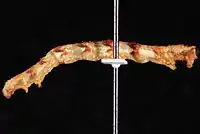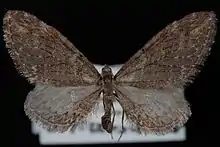Eupithecia scabrogata
Eupithecia scabrogata is a moth in the family Geometridae first described by Pearsall in 1912. It is found in western North America from British Columbia to California and Arizona.

Larva
| Eupithecia scabrogata | |
|---|---|
 | |
| Scientific classification | |
| Kingdom: | Animalia |
| Phylum: | Arthropoda |
| Class: | Insecta |
| Order: | Lepidoptera |
| Family: | Geometridae |
| Genus: | Eupithecia |
| Species: | E. scabrogata |
| Binomial name | |
| Eupithecia scabrogata | |
| Synonyms | |
| |
The wingspan is about 19 mm. The forewings are smoky brown with obscure crosslines.[3] Adults have been recorded on wing from November to March and in May, possibly representing a second generation.
The larvae feed on the flowers of Arbutus pungens.[4] They are cryptically patterned and colored to match the flowers of their host plant.
References
- Yu, Dicky Sick Ki. "Eupithecia scabrogata Pearsall 1912". Home of Ichneumonoidea. Taxapad. Archived from the original on March 24, 2016.
- "910422.00 – 7583 – Eupithecia scabrogata – Pearsall, 1912". North American Moth Photographers Group. Mississippi State University. Retrieved May 1, 2019.
- McDunnough, James H. (1949). "Revision of the North American species of the genus Eupithecia (Lepidoptera, Geometridae)" (PDF). Bulletin of the American Museum of Natural History. 93: 533–728.
- Ferris, Clifford D. (2004). "Taxonomic note on four poorly known Arizona Eupithecia Curtis (Lepidoptera: Geometridae: Eupitheciini)" (PDF). Zootaxa. 738: 1–19. doi:10.5281/zenodo.158660.
| Wikimedia Commons has media related to Eupithecia scabrogata. |
| Wikispecies has information related to Eupithecia scabrogata. |
This article is issued from Wikipedia. The text is licensed under Creative Commons - Attribution - Sharealike. Additional terms may apply for the media files.